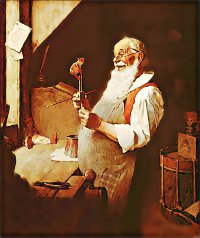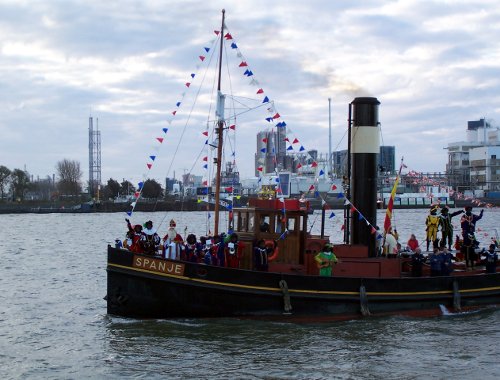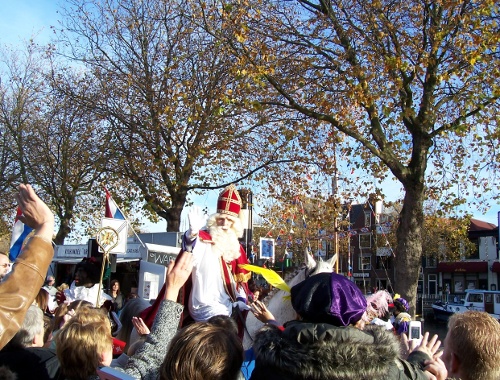We all know the answer: he is a white-bearded, jolly old man, who is exempt from getting any older, married to Mrs. Claus and lives together with his elves at the North Pole.
All year long his elves labour at making toys in their workshop, helped by Mrs. Claus, while Santa cares for Rudolf and the other reindeer. Then on Christmas Eve he magically journeys through the sky on his sleigh pulled by his team of reindeer, led by Rudolf, to the homes of all good boys and girls to deliver his gifts. Each year we hope that, along with the toys, he will bring some of that beautiful snowy weather with him and give us a white Christmas!
North Pole vs. Lapland

Santa’s Workshop by Norman Rockwell (1922). This painting was made for an advertisement that was published in the December 14, 1922 issue of the Clintonville Gazette. Photo credit: WPClipart
Actually, the Geographic North Pole is located in the Artic Ocean and is covered more or less permanently by constantly shifting sea ice, a pretty hostile place for Santa to live! A far more comfortable place for him to have his residence would be on the high snowy mountainous plains, or fell, in Finnish Lapland, named Korvatunturi. The claim that Santa Claus / Father Christmas / Joulupukki (in Finnish) lives here was first made on a radio program ‘Children’s Hour with Uncle Markus’ (translated from Finnish) hosted by Markus Rautio and broadcast by the Finnish Broadcasting Company between 1927 and 1956. Uncle Markus told his young listeners that Santa at ‘Ear Fell’ (translation of Korvatunturi) could ‘hear’ how well they were behaving throughout the year – a deciding factor as regards the gifts they could look forward to.
History of Santa Claus
Saint Nicholas and Sinterklaas
So he comes from the North Pole or Lapland, but where does he originally come from? It is largely agreed that to find this out we must study the story of Saint Nicholas. Through the centuries many stories and legends have been told about this popular saint’s life and good deeds, and although we have few hard facts, he is seen as a protector and helper to those in need. I like to think that he is also the forerunner of Santa!
Legend has it that Nicholas was born in 285 AD at Parara in Lycia, a Roman province in what is now Turkey. He immediately showed signs of being a wonder child in that he could speak from birth! His wealthy, Christian parents had been old to have a child and died during an epidemic when he was still young, whereupon Nicholas proceeded to give away all his money to the poor! According to the legend, the bishop of nearby Myra had a dream one night that the first man he saw walking in through the door of his church would become the next bishop – young Nicholas was the first person to walk in the next morning, and he did in fact become the bishop soon afterwards! In 305 AD he was consequently thrown into jail when Emperor Diocletianus began his vigorous persecution of Christians – the prisons were so full of bishops and priests that there was no space for murderers and thieves! Ten years later he was freed as Diocletianus’s successor, Constantine the 1st, had converted to Christianity, and Nicholas lived out his life peacefully, doing good works, in Myra until his death on December 6th 343 AD. (The precise dates of his birth and death seem unsure, but all agree on the day, December 6th.) When he was buried in his cathedral a strange liquid, manna, like pure water with healing powers formed in his grave, which further promoted the mystique surrounding him, and the anniversary of his death became a day of celebration, St. Nicholas Day. When, more than 700 years later, his remains were transferred to a grave in Bari on the southeast coast of Italy, supposedly a safer place for pilgrims to visit, but possibly stolen by a band of Italian seamen, the mystical liquid continued to form. Bari’s great Basilica di San Nicola still houses his remains and still draws many pilgrims and tourists.
Stories abound of how Nicholas appeared, either in the flesh during his life or in spirit after his death, to help people in trouble or need. Within a century after his death he was declared a saint, and became the patron saint of a wide variety of groups of people. A famous story tells how he stilled the water saving sailors from shipwreck in a storm, so making him the patron of seafarers and voyagers. He is also said to have saved people from famines, spared the lives of those falsely accused, returned kidnapped children safe and sound to their parents, restored murdered students to life and performed plenty of other kind deeds earning him the right to be called the patron of, among others, bankers, pawn-brokers, merchants and even robbers and murderers!
But his actions to help children, making him the patron saint of children, is the line we must follow to get to Santa Claus. On one occasion he was said to have given gold to three poor girls to provide them with dowries so that they could marry and have a respectable life, instead of having to resort to stealing or possibly even being sold into slavery! He threw small sacks of gold anonymously in through a window of their house, and these landed in shoes standing by the fire to dry. So began the custom of children setting out their shoes by the fireplace on the eve of St. Nicholas Day, hoping that a present would appear in them. Sometimes the story mentioned stockings hanging, rather than shoes standing, and gold balls, rather than bags of gold, and these became symbolized by tangerines.
Here we have the origin of Santa’s counterpart in the Netherlands, Sint Nicolaas, also known as Sinterklaas or ‘de Sint’. The custom started for children to leave their shoes by the hearth on the eve of St. Nicholas Day, so in the evening of December 5th, hoping for gifts from Sinterklaas. The tradition has grown and developed ever since. He still wears his dark red bishop’s gown and hat, carries a golden staff and brings presents, to children in the Netherlands and parts of Belgium and Germany. The modern tradition in the Netherlands owes a lot to a children’s book called ‘Sint Nicolaas en zijn knecht’, written by a Dutch primary school teacher (come poet and author) published in 1850 in which many important details were added. Sinterklaas arrives from Spain each year in a steamboat, together with a band of jolly, brightly-clad black helpers, all called Zwarte Piet, who dance and sing and hand out special cookies, ‘pepernoten’ and ‘kruidnoten’ from sacks they are carrying. The Sint himself is rather a serious, highly revered figure who rides around on a beautiful white horse. It falls to him to check in his big red book for the names of all the children who have been good throughout the year. Originally, any who had been deemed naughty were punished by being spanked with a bundle of sticks, a roe, or in extreme cases, even bundled into a sack and taken back to Spain. Of course, this punishment aspect has died out long ago, and now all children are rewarded. Parents may well still play up the ‘good behaviour’ theme, as the steamship with the eagerly awaited visitors arrives about three weeks before the big day, and children put out their shoes every evening in the hope that Sint and his entourage may pass down their road and pay them a call. They leave carrots, hay or apples in the shoes to tempt Sint’s horse to choose their house, hoping that Zwarte Piet will thank them with a little present! This celebration has become so well entrenched and is so well supported by local councils, that December 5th is a very important day in the municipal calendar in Holland. The mayor of each town turns out to ceremonially greet Sint’s steamboat, which arrives on most major pieces of water, sounding its steam hooter to announce its arrival, and children and families flock to the scene.

Sinterklaas and “Zwarte Pieten” arriving by steamboat in Vlaardingen (The Netherlands) in November 2006.
Many teenagers and grown-ups also celebrate Sinterklaas with a party held around December 5th. As the Sint only brings presents for children who believe in him, the older ones buy presents themselves (often having previously drawn lots to establish which member of the group they will buy for), and these are wrapped up in a very intricate manner, called a ‘surprise’ (with French pronunciation) and accompanied by a rhyming poem about the recipient, often highlighting one of his or her less favourable habits in a humorous way! The accent of the Sinterklaas celebration is on having fun! This frees up Christmas for the more serious business of family reunion with tastefully decorated Christmas trees, a meal with a carefully thought-out menu, and attending church to celebrate the birth of the Christ child.
Back on the trail of Santa Claus! The Dutch were great seafarers and traders, and between 1609 and 1614 an expedition of the Dutch East India Company, captained by Henry Hudson, explored and charted the region around Manhattan island, leading to the establishment of a Dutch colony there. Many adventurous Dutch people began to immigrate to the New World in search of prosperity, taking with them their tradition of the visiting Saint Nicholas. So Sinterklaas travelled across the Atlantic to call at the homes of the settlers of New Amsterdam and put gifts in the children’s shoes.
After just 40 years, New Amsterdam was to be renamed New York after an English duke. The English were also seafarers in search of new lands to take over and colonize, and James Stuart, the Duke of York, was given a package of land, including New Netherlands, by his brother King Charles the 2nd. Ships of the duke set sail to Coney Island to take possession of his territory, and after much slaughtering of local Indians at the hands of both the Dutch and the English, and much battling between the Dutch and the English, the director-general of the Dutch, Peter Stuyvesant, finally surrendered the city in 1664. The Dutch briefly won it back in 1673 calling it ‘New Orange’, but with the French surprisingly helping the British, in 1674 it once again became and remained ‘New York’.
With the new English culture, Sinterklaas gradually evolved. He ceased to be a bishop, but during the centuries that followed, his appearance ranged from tall, thin and serious to short, fat and jolly. His home changed from sunny Spain to the North Pole. Travelling from these cold northern parts, he seemed to become influenced by the legends of Norse gods, especially Thor the god of thunder and fire (incidentally, Thursday is named after him). Supposedly, he was a cheerful, friendly and heavily built old man with a white beard, who travelled on a chariot pulled by two goats, Cracker and Gnasher, making the noise of thunder, and came down chimneys into his element, fire. The emerging Santa’s clothing varied in colour; in his Thor-like depictions he was dressed in the animal skins of a hunter, despite Thor’s symbolic colour being red, from fire. In 1862, during the civil war, the cartoonist for ‘Harper’s Weekly’, Thomas Nast, drew Santa as a rather creepy elf-like figure who supported the unionists, but during the next 30 years that he drew for this magazine, he changed, among other things, the colour of Santa’s outfit from the tan animal-skin colour, or green as it was sometimes depicted, to red.
Modern-day Santa Claus
Most people agree that the final appearance and clothing of the modern-day Santa is derived from Coca Cola advertising from the 1930’s onwards. Coca Cola wanted to get away from the image of its drink being only a summer drink, and decided to link up with the icon for winter, Santa Claus. Actually, they were not the first soft-drinks company to do this as ‘White Rock Beverages’ had used Santa to help sell their mineral water from 1915. Anyway, in 1930 the artist Fred Mizen was commissioned by Coca Cola to make an advertising poster featuring Santa drinking a bottle of cola in a crowd in ‘Famous Barr Co.’ department store in St. Louis. However, it was the famous series of oil paintings by artist Haddon Sundblom (in one of which Santa, watched by a little girl, is raiding the fridge for a cola) that really established the modern image of our fat, jolly Santa. To some extent, Sundblom drew on features of Santa mentioned in Clement C. Moore’s famous poem, ‘A visit from St. Nicholas’ (sometimes called ‘T’was the night before Christmas’), written in 1825: ‘His eyes – how they twinkled! His dimples so merry’, ‘He had a broad face and a little round belly that shook when he laughed like a bowl full of jelly’. Also thanks to this poem, Santa travelled on a sleigh pulled by his team of reindeer, Dasher, Dancer, Prancer, Vixen, Comet, Cupid, Donner and Blitzen – (interesting that ‘donner’ and ‘blitzen’ are the Dutch words for thunder and lightning!) So, as in the case of Sinterklaas, details were added via literature.
The ninth and lead reindeer, Rudolph came later in 1939 as a character in a story and song ‘Rudolph the red nosed reindeer’ by Robert L May. He wrote this as an assignment for his employer, Montgomery Ward (a large chain of department stores in America, also the first ever mail-order company and now an online retailer, Ward Retail Limited) who had been buying and giving away colouring books for Christmas each year as promotional gifts, and realized that they could save a lot of money by producing their own book!
Well, the story is complete as, since 1939, although very many things have changed dramatically in our world, it seems that not much has changed with Santa, except that the presents have increased in number, size and cost! Maybe we have our answer to the title question. Sorry it has been a rather long story – I hope Santa will reward you for your perseverance in ploughing through it! You deserve a medal, let alone a gift from Santa!





